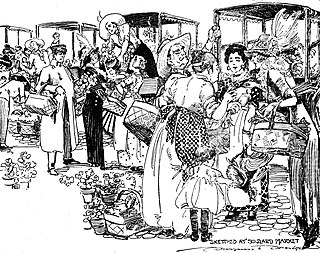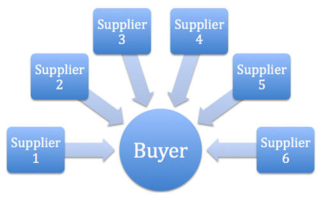
In production, research, retail, and accounting, a cost is the value of money that has been used up to produce something or deliver a service, and hence is not available for use anymore. In business, the cost may be one of acquisition, in which case the amount of money expended to acquire it is counted as cost. In this case, money is the input that is gone in order to acquire the thing. This acquisition cost may be the sum of the cost of production as incurred by the original producer, and further costs of transaction as incurred by the acquirer over and above the price paid to the producer. Usually, the price also includes a mark-up for profit over the cost of production.

In finance, a futures contract is a standardized legal contract to buy or sell something at a predetermined price for delivery at a specified time in the future, between parties not yet known to each other. The asset transacted is usually a commodity or financial instrument. The predetermined price of the contract is known as the forward price. The specified time in the future when delivery and payment occur is known as the delivery date. Because it derives its value from the value of the underlying asset, a futures contract is a derivative.
Cost-plus pricing is a pricing strategy by which the selling price of a product is determined by adding a specific fixed percentage to the product's unit cost. Essentially, the markup percentage is a method of generating a particular desired rate of return. An alternative pricing method is value-based pricing.
In theories of competition in economics, a barrier to entry, or an economic barrier to entry, is a fixed cost that must be incurred by a new entrant, regardless of production or sales activities, into a market that incumbents do not have or have not had to incur. Because barriers to entry protect incumbent firms and restrict competition in a market, they can contribute to distortionary prices and are therefore most important when discussing antitrust policy. Barriers to entry often cause or aid the existence of monopolies and oligopolies, or give companies market power. Barriers of entry also have an importance in industries. First of all it is important to identify that some exist naturally, such as brand loyalty. Governments can also create barriers to entry to meet consumer protection laws, protecting the public. In other cases it can also be due to inherent scarcity of public resources needed to enter a market.
Procurement is the method of discovering and agreeing to terms and purchasing goods, services, or other works from an external source, often with the use of a tendering or competitive bidding process. The term may also refer to a contractual obligation to "procure", i.e. to "ensure" that something is done. When a government agency buys goods or services through this practice, it is referred to as government procurement or public procurement.
An invoice, bill or tab is a commercial document issued by a seller to a buyer relating to a sale transaction and indicating the products, quantities, and agreed-upon prices for products or services the seller had provided the buyer.
A real estate contract is a contract between parties for the purchase and sale, exchange, or other conveyance of real estate. The sale of land is governed by the laws and practices of the jurisdiction in which the land is located. Real estate called leasehold estate is actually a rental of real property such as an apartment, and leases cover such rentals since they typically do not result in recordable deeds. Freehold conveyances of real estate are covered by real estate contracts, including conveying fee simple title, life estates, remainder estates, and freehold easements. Real estate contracts are typically bilateral contracts and should have the legal requirements specified by contract law in general and should also be in writing to be enforceable.
Purchasing is the process a business or organization uses to acquire goods or services to accomplish its goals. Although there are several organizations that attempt to set standards in the purchasing process, processes can vary greatly between organizations.
Construction management (CM) is a professional service that uses specialized, project management techniques and software to oversee the planning, design, construction and closeout of a project. The purpose of construction management is to control the quality of a project's scope, time / delivery and cost—sometimes referred to as a project management triangle or "triple constraints." CM is compatible with all project delivery systems, including design-bid-build, design-build, CM At-Risk and Public Private Partnerships. Professional construction managers may be hired for large to jumbo-scale, high budget undertakings, called capital projects.

The revenue recognition principle is a cornerstone of accrual accounting together with the matching principle. They both determine the accounting period in which revenues and expenses are recognized. According to the principle, revenues are recognized when they are realized or realizable, and are earned, no matter when cash is received. In cash accounting—in contrast—revenues are recognized when cash is received no matter when goods or services are sold.
Closing costs are fees paid at the closing of a real estate transaction. This point in time called the closing is when the title to the property is conveyed (transferred) to the buyer. Closing costs are incurred by either the buyer or the seller.
Flipping is a term used to describe purchasing a revenue-generating asset and quickly reselling it for profit.

A business can use a variety of pricing strategies when selling a product or service. To determine the most effective pricing strategy for a company, senior executives need to first identify the company's pricing position, pricing segment, pricing capability and their competitive pricing reaction strategy. Pricing strategies and tactics vary from company to company, and also differ across countries, cultures, industries and over time, with the maturing of industries and markets and changes in wider economic conditions.
A cost-plus contract, also termed a cost plus contract, is a contract such that a contractor is paid for all of its allowed expenses, plus additional payment to allow for a profit. Cost-reimbursement contracts contrast with fixed-price contract, in which the contractor is paid a negotiated amount regardless of incurred expenses.

The point of total assumption (PTA) is a point on the cost line of the profit-cost curve determined by the contract elements associated with a fixed price plus incentive-Firm Target (FPI) contract above which the seller effectively bears all the costs of a cost overrun. The seller bears all of the cost risk at PTA and beyond, due to a dollar for dollar decrease in profit beyond the costs at the PTA. In addition, once the costs on an FPI contract reach PTA, the maximum amount the buyer will pay is the ceiling price. Note, however, that between the cost at PTA and when the cost equals the ceiling price, the seller is still in a profitable position; only after costs exceed the ceiling price is the seller in a loss position.
A power purchase agreement (PPA), or electricity power agreement, is a long-term contract between an electricity generator and a customer, usually a utility, government or company. PPAs may last anywhere between 5 and 20 years, during which time the power purchaser buys energy at a pre-negotiated price. Such agreements play a key role in the financing of independently owned electricity generators, especially producers of renewable energy like solar farms or wind farms.
A cost-plus-incentive fee (CPIF) contract is a cost-reimbursement contract that provides for an initially negotiated fee to be adjusted later by a formula based on the relationship of total allowable costs to total target costs.

In the retail industry, a buyer is an individual who selects what items are stocked and their key responsibility is dealing with all the products that come into the store. Buyers usually work closely with designers and their designated sales representatives and attend trade fairs, wholesale showrooms and fashion shows to observe trends. They are employed by large department stores, chain stores or smaller boutiques. For smaller independent stores, a buyer may participate in sales as well as promotion, whereas in a major fashion store there may be different levels of seniority such as trainee buyers, assistant buyers, senior buyers and buying managers, and buying directors. Decisions about what to stock can greatly affect fashion businesses.

A reverse auction is a type of auction in which the traditional roles of buyer and seller are reversed. Thus, there is one buyer and many potential sellers. In an ordinary auction also known as a forward auction, buyers compete to obtain goods or services by offering increasingly higher prices. In contrast, in a reverse auction, the sellers compete to obtain business from the buyer and prices will typically decrease as the sellers underbid each other.
A construction contract is a mutual or legally binding agreement between two parties based on policies and conditions recorded in document form. The two parties involved are one or more property owners and one or more contractors. The owner, often referred to as the 'employer' or the 'client', has full authority to decide what type of contract should be used for a specific development to be constructed and to set out the legally-binding terms and conditions in a contractual agreement. A construction contract is an important document as it outlines the scope of work, risks, duration, duties, deliverables and legal rights of both the contractor and the owner.





